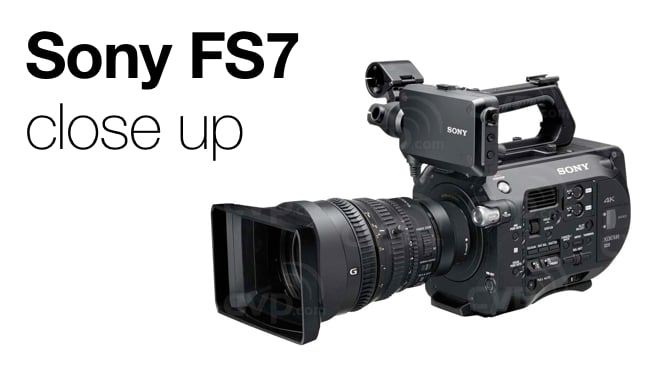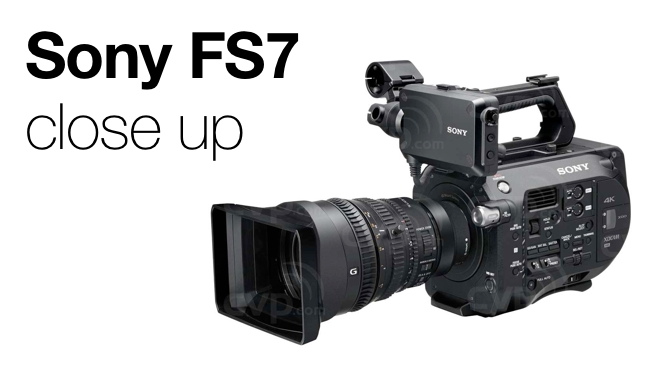
 Sony FS7 Close Up
Sony FS7 Close Up
The PXW-FS7 is a camera with an extremely wide range of talents. We've had a close look at it, prior to our full "hands-on" review which will arrive shortly
When I was talking to several hundred fellow professionals, prosumers and other customers at Photokina 2014 in Cologne, Germany, last month (I was working freelance on the Sony booth as a Sony accredited expert), the sentence I heard from them most was "this is the camera that we've been waiting for!".
And you can see why people were excited, even although the camera was a pre-production model, shipped directly from Japan with a firmware beta update one day before the show started.
The 4K Super 35mm Exmor CMOS sensor camera with its new form factor is designed to fit directly in line between the smaller FS700 and bigger F5 / F55 line-up and should prove to be as versatile as its market position suggests it should be.
It will fit into the well-established Sony workflow with XDCAM HD and XAVC fully available and easily editable with all professional editing suites (Sony Vegas, Adobe CC, Edius, Apple Final Cut Pro X, Grass Valley, Quantel, etc.), within on-set daily environments (Assimilate, Codex, Colorfront, FilmLight, MTI and YoYotta) and for colour grading (Assimilate, FilmLight, Davinci Resolve and Quantel).
α lens mount system is a big advantage
The α lens mount system with the Sony E-mount is a big advantage, as it brings the widest possible degree of compatibility with lenses you might already own. The very short flange focal distance means you can use adaptors for all other common mount types including PL, EF, Nikon, Sony A-mount (with LA-EA4) and many more. Autofocus and other lens-controls are available with these professional adaptors. Even autofocus looked really nice on first impressions with Alpha lenses – originally designed to work for stills photography. I tried out the LA-EA4 and multiple lenses on the FS7.
Technical specifications, like continuous internal recording up to 59,94 fps in 4K* and 180 fps in HD resolution (both without cache limitations), 14 Stops dynamic range and full flexibility with S-Gamut3.Cine / S-Log3 (and other logarithmic curves) are only the tip of the iceberg with this camera.
It's quite clear that this camera is suitable for a very wide range of uses, ranging from TV news (ENG) up to cinematic purposes for TV drama and independent cinema.
For the latter, the camera can be connected to the HXR-IFR5 dock (originally designed to fit Sony’s FS700) to record 4K/2K at 12bit RAW continuously onto the R5 recorder’s AXS memory – fully flexible with up to 240 fps until the card is full. On the other hand you can use the FS7 for TV production, with standard gamma curves (no further grading needed; e.g. STD5 - Rec.709) and internal recording in the well-known and broadcast standard XDCAM HD422.
Native Apple ProRes HQ 422 in HD will also be possible internally with a future upgrade with the XDCA-FS7 extension unit. This add-on also brings V-Mount, Genlock, Ref-Out, DC-In (12V), DC-Out (Hirose) and TC In/Out to the camera and the option to connect not only Sony’s own but also third-party external recorders.
First impressions
My first impressions, from the tests I have managed to carry out with the camera, are that it has been designed for run and gun style shooting for single person operation, whilst not forgetting about cinematic use. For example, the three record buttons, which can be configured individually to start simultaneous recording to both card slots or to slots A or B individually, are perfect for multi-person operation.
And Sony seems to have thought about all sorts of different weather conditions as well with their dust-proof and drip-proof design to tackle harsh environments.
Multiple viewfinder options are provided and additional screens may be attached but a great 2 megapixel OLED viewfinder is included with a professional grade eyepiece that I feel will be comfortable for long-term use.
Stripped down to the body (there's a detachable top handle and adjustable arm), the size of the camera is perfect for drone, gimbal, steadicam, crane, slider and other special gear operations. Due to the low weight of only 2 kg (body only) and 4.5 kg (with Viewfinder, Eyepiece, Grip Remote Control, BP-U30 battery, the heavier SELP28135G lens and XQD memory card) there are very few limitations for all of these purposes, since lighter-weight lenses may be used as well.
Size, comfort, flexibility and weight – thus usability and interoperability – to me personally reach a level beyond comparison to other similarly pitched cameras coming to the market in the next few months.
There's another innovation that puts the FS7 into a league of its own: the superb hand grip with ARRI rosette. Loads of people have said to me "Why hasn’t someone else come up with this earlier?“. And honestly it is a great way to use the camera on your shoulder straight out of the box with an adjustable arm (length and orientation) with hand grip (freely rotatable) that is designed to nicely fit on the shoulder. (If needed for longer periods, you may buy an additional shoulder mount, as the included one is not meant to replace a fully professional one).
Essential NDF
Multiple programmable buttons on the hand grip to navigate the menu, additional assign buttons, a smooth zoom lever for servo zoom lenses and REC start / stop fulfil the dream of many cameramen.
Another essential feature is the 4 position ND filter wheel. It is a well positioned metal component that slides the high-grade ND filters: clear, ¼, 1/16 and 1/64 with density values 0, 0.6, 1.2, and 1.8 comfortably in and out.
While shooting under low-light conditions, I tried to test the camera at up to 6400 ISO (18 db gain) with its improved sensor sensitivity in the Exmor CMOS series and found there was only a low noise-level, that certainly could easily be removed almost completely with professional grade software just like Red Giant Magic Bullet De.Noiser II or Neat Video.
One very nice option that you might not notice immediately is the built-in Multi-Interface (MI) Shoe that sits on top of the camera. It offers connections to accessories such as UWP series microphone sets (without additional power or audio cables) or to control light (HVL-LBPC; optional) and can be combined with other gear as well.
Finally there are also some major improvements that I noticed, where Sony listened carefully to their customers and professional filmmakers from around the world. The viewfinder connector (VF) and two XLR connectors have been repositioned to more convenient positions. They fit and are located in locations where they neither distract the typical camera interaction nor block ways of movement. Additionally the VF connector is in a non-risky position, where cables of interchangeable viewfinders will work well.
* QFHD 3840 x 2160 from launch. 4K at 4096 x 2160 with firmware update, early 2015.
Tags: Technology



Comments